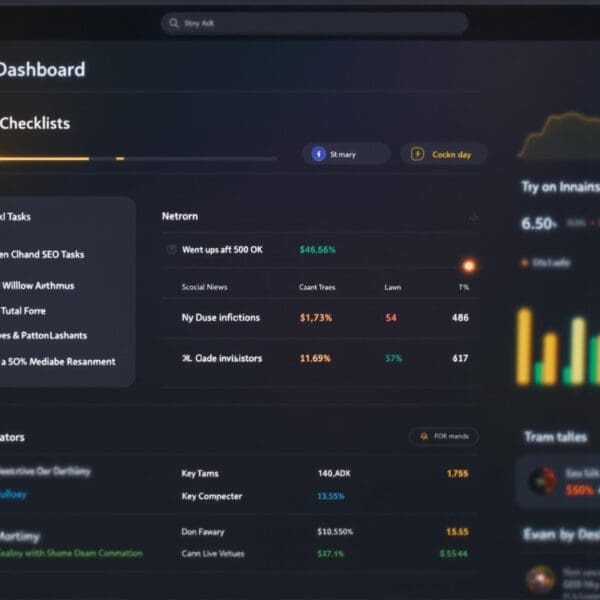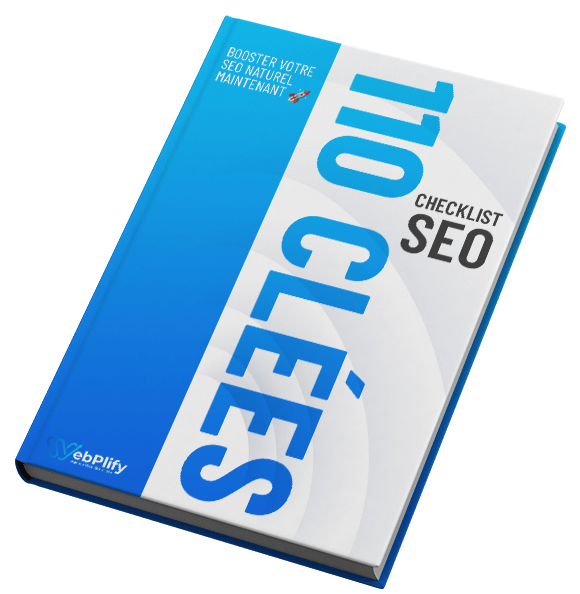Search Engine Optimization ( SEO ) is a key element of any effective digital strategy. It involves optimizing your website to improve its search engine ranking and attract more organic traffic. In 2024, SEO practices are evolving with algorithm updates and new technologies. Here are 14 essential keys to optimizing your site and keeping it competitive in search results.
To optimize your website’s SEO in 2024, here are the 14 essential keys summarized :
- Choosing the right keywords: Select specific, long-tail keywords to attract qualified traffic.
- HTML tag optimization: Set up optimized title tags, meta descriptions and headers.
- Quality content: Create relevant, engaging content that meets your audience’s expectations.
- Improved UX: Offer fluid navigation with a fast site.
- Image optimization: Reduce image size and add descriptive alt tags.
- Internal and external links: Link your pages and include quality external links.
- Mobile optimization: Make sure your site is responsive.
- Loading speed: Improve loading times for a better experience.
- Structured data: Use schemas to enrich your results in the SERPs.
- Voice search: adapt your content to voice queries.
- Quality backlinks: Get inbound links from credible sites.
- Local SEO: Optimize to attract customers in a specific geographic area.
- Performance tracking: Monitor and adjust your SEO efforts on a regular basis.
- Updating content: Update your articles regularly to stay relevant.
These techniques help to boost visibility, attract more visitors and improve your search engine rankings.
Search Engine Optimization ( SEO ) is a key element of any effective digital strategy. It involves optimizing your website to improve its search engine ranking and attract more organic traffic. In 2024, SEO practices are evolving with algorithm updates and new technologies. Here are 14 essential keys to optimizing your site and keeping it competitive in search results.
Table of contents
Toggle1. Choosing the right keywords
Keyword selection is the foundation of an effective SEO strategy. It’s about selecting the terms your potential customers use to find services or products similar to yours. In 2024, the emphasis is more on long-tail keywords (specific, longer phrases) and keywords associated with a clear search intent.
What to do:
- Use tools like Google Keyword Planner, Ahrefs, and SEMrush to identify high-potential keywords.
- Analyze the search intentions behind keywords to better adapt your content.
- Integrate long-tail keywords, as they attract more qualified traffic. For example, instead of targeting “shoes”, target “lightweight running shoes for women”.
Example:
- Main keyword: agence SEO Montréal
- Longtail keyword: best SEO agency in Montreal for small businesses
2. On-Page Optimization of HTML Tags
Optimizing HTML tags is essential for search engines to understand the content of your page. Title, meta description and header tags (H1, H2, H3) must be optimized to include keywords and clearly describe the subject of each page.
What to do:
- Write unique, attractive titles for each page, including your main keyword.
- Use concise, engaging meta descriptions to entice users to click. Descriptions should include keywords and action verbs.
- Structure your content with H1, H2, H3 tags in a hierarchical manner to facilitate reading and indexing by Google.
Optimization example :
- Title: Agence SEO à Montréal – Optimize your Search Engine Optimization
- Meta description: Improve your visibility on Google with our Montreal SEO agency. Tailor-made strategies to attract more qualified traffic.
3. Creating quality content
Quality content is at the heart of any SEO strategy. In 2024, Google favors sites that provide useful, comprehensive and well-written information. Relevant content not only attracts more traffic, but also encourages users to spend more time on your site, reducing bounce rates.
What to do:
- Create blog posts, case studies, guides and FAQs that answer your audience’s questions and needs.
- Use secondary keywords and keyword variations to enrich content and cover a topic exhaustively.
- Update your content regularly to keep it relevant and optimized.
Example:
- Write a blog post on the latest SEO trends with practical advice, such as“5 tips to improve your SEO in 2024“.
4. Improving the User Experience (UX)
User experience (UX) indirectly influences SEO ranking. If users find your site pleasant to navigate and easily accessible, they’ll stay longer, sending positive signals to Google. A well-structured site with an intuitive design is essential for good SEO.
What to do:
- Make sure your site is easy to navigate, with clear menus and a fluid user path.
- Improve your site’s loading speed, as a slow site increases the bounce rate.
- Use clear, visible call-to-action (CTA) buttons to guide your users to specific actions.
Example:
- Optimize the home page with well-defined sections, light images and CTA buttons like “Request a free quote” or “Contact us now”.
5. Image optimization
Images are essential elements in making a site attractive, but they must be optimized so as not to slow down loading speed. An unoptimized image can slow down the site and negatively affect your ranking.
What to do:
- Use tools like TinyPNG or ImageOptim to compress images without sacrificing quality.
- Give your images descriptive file names including keywords, and add optimized alt tags.
- Use lighter image formats such as WebP to improve loading times.
Example:
- Instead of naming an image “IMG_1234.jpg”, use “référencement-naturel-montreal.jpg” and add an alt tag like “SEO strategy for businesses in Montreal”.
6. Using internal and external links
Internal links help connect the different pages of your site, making it easier for users to navigate and improving indexing by Google. External links to quality sites reinforce the credibility of your content.
What to do:
- Include relevant internal links in your articles to direct visitors to other important pages on your site.
- Add external links to reliable sources to back up your claims and show Google that you’re providing comprehensive information.
Example:
- In a blog post, link internally to your services page with the anchor “Discover our SEO services in Montreal”. Add an external link to a recognized SEO guide like Moz‘s.
7. Mobile Optimization
With over 60% of searches carried out on mobile devices, Google now uses mobile-first indexing. This means that the mobile version of your site is crucial to your SEO ranking.
What to do:
- Use a responsive design that automatically adapts to different screen sizes.
- Test your site on multiple devices to ensure a smooth user experience.
- Minimize CSS and JavaScript files to speed up loading times on mobile devices.
Example:
- Use Google’s Mobile-Friendly Test tool to check whether your site is optimized for mobile devices.
8. Site Speed Optimization
Loading speed is a major ranking factor. A slow site not only increases the bounce rate, but also penalizes your Google ranking.
What to do:
- Enable caching to temporarily store certain site data in users’ browsers.
- Use a content distribution network (CDN) to distribute content from servers closer to users.
- Minimize CSS, HTML and JavaScript files to reduce their size.
Example:
- Use Google PageSpeed Insights to evaluate your site’s speed and get recommendations on how to improve its performance.
9. Using Structured Data (Schema.org)
Structured data are tags you can add to your HTML code to help search engines better understand the content of your page. They also allow you to benefit from rich snippets, such as star ratings or recipes, in search results.
What to do:
- Use Schema.org to add structured data tags to your products, blog posts or events.
- Implement rich snippets to display additional information such as reviews, prices and events in search results.
Example:
- For a product page, add a product schema with price, user reviews and availability.
10. Voice Search Optimization
With the increase in searches via voice assistants like Google Assistant and Alexa, it’s important to adapt your site for voice search. These queries are often longer and in the form of questions.
What to do:
- Optimize your content for conversational phrases and common questions.
- Include FAQ sections on your pages to answer any questions users may have.
Example:
- Create a page that answers questions such as- “How can I optimize my site for voice search in 2024?”.
Add direct answers to frequently asked questions to anticipate what users will ask voice assistants.
11. Backlink optimization
Backlinks are links from other sites pointing to yours. Having high-quality backlinks is one of the most important factors in improving your Google ranking.
What to do:
- Create original content that encourages other sites to refer to you.
- Participate in guest articles on relevant blogs in your sector.
- Monitor your backlinks and disavow those from low-quality sites.
Example:
- Use a tool like Ahrefs to monitor your backlinks, and contact influential blogs in your field to obtain links.
12. Local SEO optimization
Local SEO is crucial if you want to attract customers to a specific geographic area. In 2024, with the rise of “near me” searches, local SEO has become a priority for many businesses.
What to do:
- Make sure your company is listed on Google My Business with correct and up-to-date information.
- Encourage your customers to leave Google reviews, as these influence your local ranking.
- Use local keywords in your page titles and descriptions.
Example:
- Optimize your Google My Business listing with recent photos, opening hours and responses to customer reviews.
13. SEO performance monitoring
It’s essential to track the performance of your SEO strategy to measure its effectiveness and make adjustments where necessary. Use analytics tools to monitor rankings, traffic and conversions.
What to do:
- Use Google Analytics to track traffic statistics and conversions.
- Install Google Search Console to monitor your keywords and the performance of your pages in the SERPs.
- Track your keyword rankings with tools like Ahrefs or SEMrush.
Example:
- Regularly analyze performance reports to identify pages that need improvement or content updates.

14. Regular Content Updates
Google favors sites that regularly publish and update their content. Keeping your site up to date with relevant information shows Google that your site is active, which can improve its ranking.
What to do:
- Update your blog posts and key pages with the latest information.
- Remove or merge obsolete content to avoid keyword cannibalization.
- Regularly add new articles or case studies to demonstrate your expertise.
Example:
- Update a blog post on SEO in 2023 with the latest trends and tips for 2024.
Conclusion
These 14 SEO keys are essential for optimizing your website and attracting qualified traffic in 2024. By combining solid content strategies, technical optimization and quality backlinks, you can not only improve your Google rankings, but also provide a better user experience for your visitors.
SEO is an ongoing process that requires regular adjustments to remain effective, so don’t hesitate to test and improve your strategy as you go along.
If you follow these tips, you’ll be well on your way to seeing tangible, lasting SEO results!















